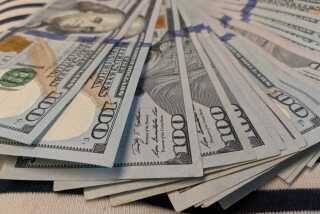Bright side of dollar’s drop: smaller trade gap
Friday’s news that the trade deficit narrowed in August shows the silver lining from dollar’s steep drop.
The greenback has been declining relative to other major currencies for months. Concerns are growing that foreign investors might curtail their investments in dollar assets.
But so long as the slide remains gradual and orderly, economists generally view it as a plus for the U.S. economy. Though a weak dollar makes imported goods such as oil more expensive, it boosts the competitiveness of U.S. exporters, helping to rebalance an economy that has been skewed away from exports for years.
In August, the gap between what the U.S. exports versus what it imports narrowed to $30.7 billion, from $31.9 billion, as exports rose and imports fell, the Commerce Department said Friday.
The dollar is down 14% against other major currencies since March.
This week fears deepened in the world’s political and financial capitals over the future of the currency, starting with reports that foreign governments were looking for alternatives to the dollar as a “reserve currency.”
Part of the recent decline in the dollar simply reverses the artificial boost it received during the depths in the financial crisis, when investors put their money into dollar investments seen as safe.
But there is a broader fear in markets: that the steep-but-gradual decline of the dollar could give way to a rout, the kind of self-reinforcing run on the currency that occurs semi-regularly in developing nations with shaky finances.
“There seems to be a paradigm shift underway where more and more foreign investors are becoming concerned that the long-term path of the dollar is downward,” said Bernard Baumohl, chief global economist at Economic Outlook Group.
In a run on the dollar, that thinking would create a cascade -- fearful global investors would shy away from dollars, expecting further steep declines, creating a self-fulfilling prophecy.
Analysts generally think that if such a pattern were to develop, as happened in East Asian nations in the late 1990s and in Argentina early in this decade, world governments would probably take aggressive actions to combat it.
That’s because everyone has something to lose.
In the U.S., such an event would drive up the price of imports dramatically, making it much more expensive to finance the government’s debt. That could lead the Federal Reserve to raise interest rates and potentially drive the economy back into recession.
Exporters in Europe and Japan would be much less competitive, damaging those economies. China has based its entire economic policy for years around keeping its own currency low against the dollar to encourage exports, a strategy that would be undermined by a disorderly decline in the dollar.
But though government officials have closely monitored the jitters in the foreign exchange markets this week, there were no signs the U.S. government was considering intervening in currency markets to prop up the dollar.
The concerns about the dollar reflect anxiety in financial markets over U.S. economic policy. With the budget deficit exceeding 10% of gross domestic product this year and the path to lowering deficits unclear, some investors have doubts about the government’s commitment to fiscal sustainability.
More to Read
Inside the business of entertainment
The Wide Shot brings you news, analysis and insights on everything from streaming wars to production — and what it all means for the future.
You may occasionally receive promotional content from the Los Angeles Times.










